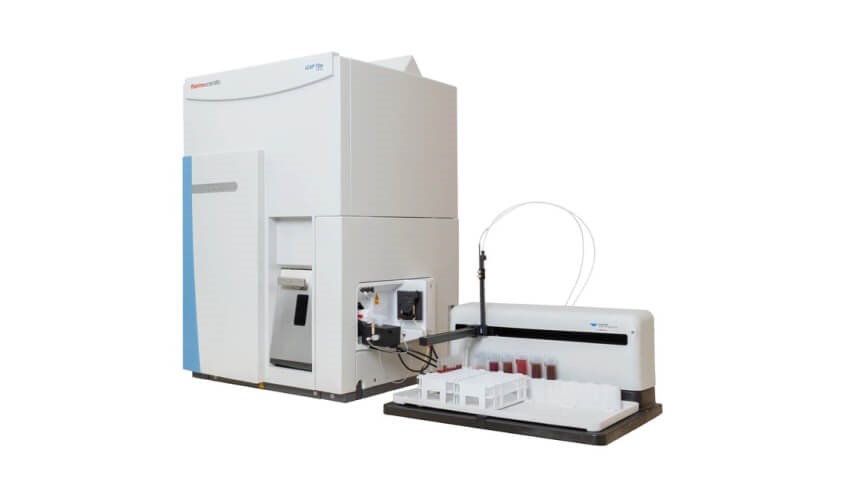
ICP-MS Analysis

Qualitative and quantitative (ppb) elemental analysis
ICP-MS (inductively coupled plasma-mass-spectrometry) is a technique to determine low concentrations (range: ppb = parts per billion = µg/l). ICP (Inductively Coupled Plasma) Spectroscopy is an analytical technique used to measure and identify elements within a sample matrix based on the ionization of the elements within the sample. Mass Spectrometer (MS) separates the ions out by their mass-to-charge ratio after going through the ICP, and the detector counts the number of selected ions per second which allows the instrument to determine the concentration of each chosen element.
ICP-MS analysis requires the use of liquefied sample solutions. The sample solution is introduced into the device where it becomes nebulized in a spray chamber. Aerosol samples are transported into the core of the inductively coupled argon plasma, where they are completely desolvated, atomized, and ionized. These ions are then extracted from the plasma by skimmer and interference cones and extraction lenses. After going through the lenses, the ion particles are further refined by going through an off-axis ion lens removing photons and neutral ions, reducing background noise.
Polyatomic ions which act as interferences are removed using kinetic energy discrimination, where the larger polyatomic ions lose energy faster than the analyte ions and are easily removed from the sample beam. From there, the beam of ions travels into the hyperbolic quadrupole of the mass spectrometer and the ions are separated by their mass-to-charge ratio, allowing only the selected ions to travel on towards the detector to be measured and reported by the ICP-MS in terms of counts per second and concentration. The system can detect element from Lithium to Uranium.
- Organic compounds
- Pharmaceuticals
- Food & Agricultural Industries
- Chemistry & Chemical Engineering
- Geological & Environmental samples
- Organometallics
- Gasoline and fuels
- Coal and coke
- Graphite and carbides
- Metals and alloys
- Polymers and explosives
- Building materials and your samples
- Sample must be pure and all contaminants must be removed.
- Sample weight should be in between 5-10 gm.
- Biological and non-biological samples can analyses
- In case of liquid sample minimum 25 ml is required for processing
User Charges
| Nature of samples | Charges | Charges |
|---|---|---|
| Liquid sample which does not require any preparation | Rs. 2000 per sample for 23 elements (Ag, Al, B, Ba, Bi, Ca, Cd, Co, Cu, Cr, Fe, Ga, In, K, Li, Mg, Mn, Na, Ni, Pb, Sr, Tl, Zn) |
Rs. 300 per extra element (Mo, Ti, Hg, Se, Sb, I, As, Pt) |
| A sample which require preparation using microwave digestion | Rs. 3500 per sample for 23 elements (Ag, Al, B, Ba, Bi, Ca, Cd, Co, Cu, Cr, Fe, Ga, In, K, Li, Mg, Mn, Na, Ni, Pb, Sr, Tl, Zn) |
Rs. 300 per extra element (Mo, Ti, Hg, Se, Sb, I, As, Pt) |
*External users must pay extra 18 % GST
The sample digestion procedure for other than textile and biomass sample should be informed by the customer in case of solid samples.
- Back to previous page
- |
-
Page last updated date:22-04-2024 12:44 PM












